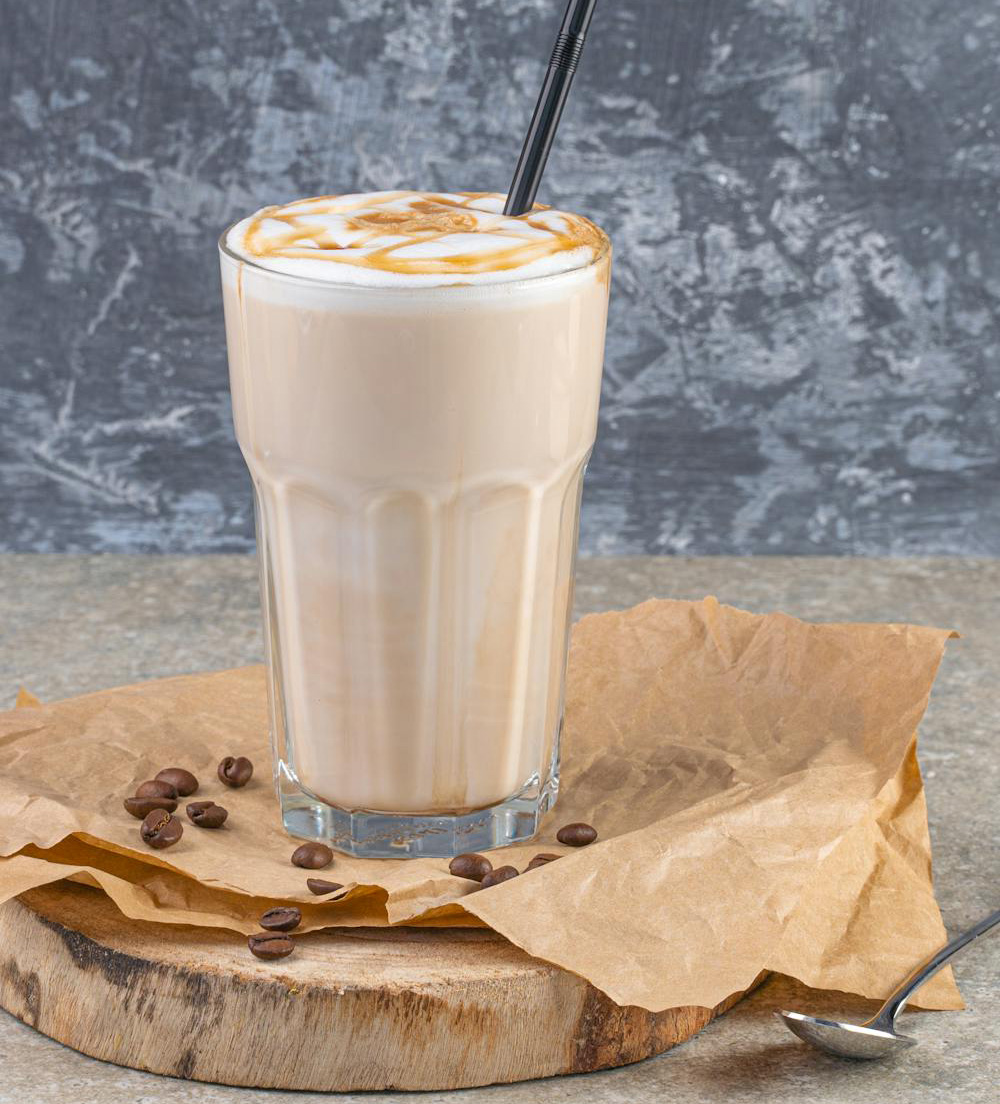
In the world of coffee, change is constant. New brewing methods emerge, new types of beans are discovered, and new ways to prepare and drink coffee are developed all the time. We like to stay ahead of the curve and bring you the latest coffee trends. So we’ve put together a list of the 5 coffee trends that will be big in 2024.
The global coffee industry is booming, and it doesn’t look like it’s going to slow down anytime soon. In fact, according to recent forecasts, the coffee market is expected to grow by another 4.4% in 2024. That’s a lot of coffee! So what does the future hold for all of us coffee lovers? Read on to find out what’s in store for the world of coffee!
One of the biggest coffee trends in 2024 is the rising demand for cold coffee drinks. Over recent years, cold coffee has evolved from a popular summer menu item into a year-round essential in cafes around the world.
In fact, Starbucks, in its 2022 Q2 sales report, revealed that approximately 75% of its total drink sales during that period were attributed to cold coffee beverages. What’s more is that cold foam is the fastest growing drink add-on and also the most expensive at $1.25.
From automatic machines that grind and brew the beans to commercial milk frothers for faster latte art production, there is a growing selection of high-quality coffee equipment available on the market.
As one example, Latte Art Factory, a milk frothing machine, allows you to create a wide variety of foaming options for all hot and cold coffee drinks, reduce staff training and focus more on your customers.
With the Latte Art Factory, you can ensure perfect milk foam for any type of milk and optimize your workflow at the same time. This is perfect for busy coffee shops that want to create beautiful latte art without sacrificing speed or quality.
Another trend continuing in 2024 is hands-free brewing. Right now, there is a global staffing shortage for baristas, so many coffee shops are turning to automated brewing and frothing methods to help take the load off their staff. Automated brewing machines are becoming increasingly popular due to their ability to produce consistent high-quality coffee drinks at the touch of a button.
One of the big coffee trends continuing in 2024 is the focus on sustainability. Coffee drinkers are increasingly interested in where their coffee comes from and are choosing to support businesses that use ethical practices while brewing their favorite cup of Joe. Everyone interested in buying coffee equipment is shifting their focus to products that are sustainably sourced and minimize waste.
One such solution is our very own Latte Art Factory milk frothing machine, which saves up to 25% on milk waste. By saving on leftovers and spillage, more of the milk goes towards your drink, and less goes to waste. We are very proud of this product, and we think it’s a great example of how businesses can be sustainable while still providing high-quality coffee drinks.
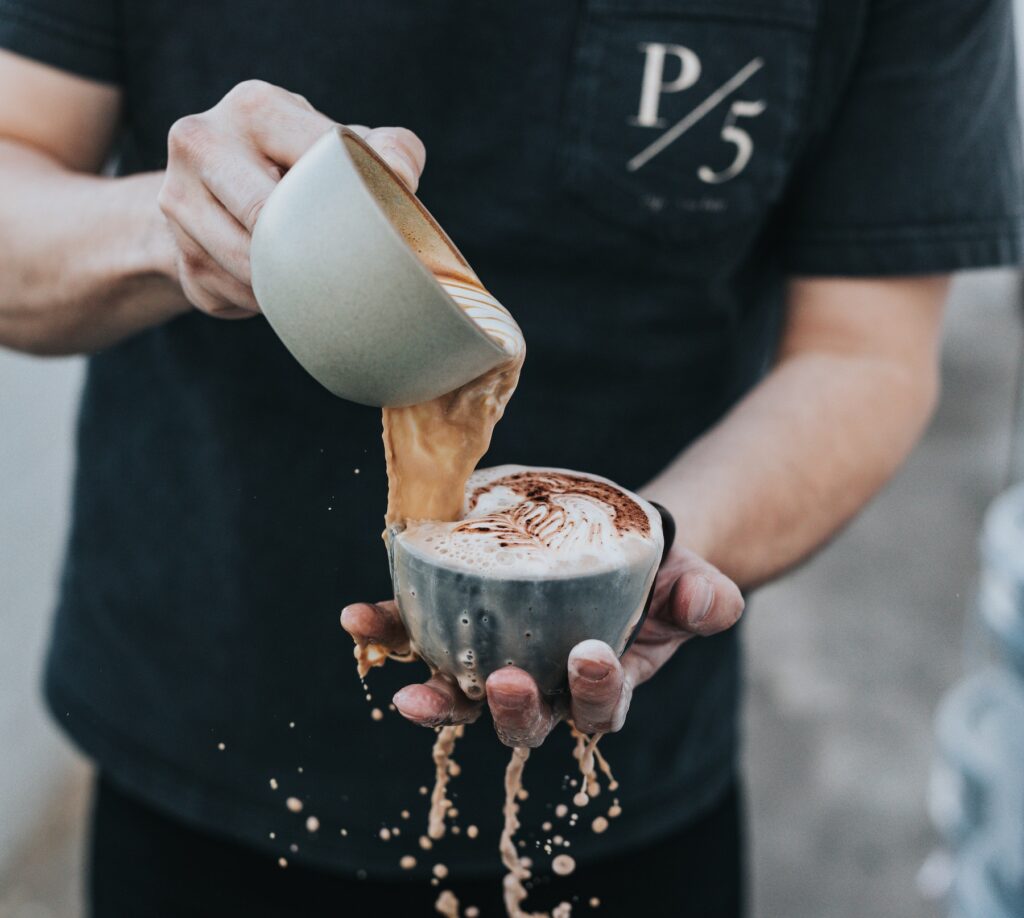
In 2024, brace yourself for a rise in specialty coffee. There has been a huge resurgence in interest in specialty coffee, and people are increasingly interested in buying coffee beans from local businesses. Local roasters are often small businesses that take great care in selecting and roasting their beans to perfection.
The specialty coffee sector has witnessed impressive expansion in recent years, driven by a number of factors. These include shifting consumer preferences, heightened awareness regarding coffee sourcing and production methods, and a growing demand for high-quality coffee experiences.
It’s no secret that dairy milk is becoming less and less popular. According to reports, sales of dairy milk have been dropping steadily for years as more and more people switch to plant-based milks. And it’s not just soy milk anymore – there are a host of new non-dairy milks on the market, from pea and oat milk to potato milk, the most recent newcomer in 2023.
Brands specializing in plant-based milk are formulating blends designed specifically for baristas to achieve that coveted frothy texture. Crafted with the barista in consideration, these non-dairy milk substitutes are positioned to create excellent microfoam.
People often see plant-based milks as healthier than dairy milk. Many prefer plant-based milks because they require fewer resources to produce than dairy milk, and this makes them more sustainable.

It looks like 2024 is shaping up to be a big year for coffee innovation, so make sure you’re ready for these five coffee trends.
Whether you’re traveling through South India or across Latin America, the
majority of coffee options call for an added dairy or alternative milk
addition. Many years ago, dairy was added to coffees to up people’s calorie
intake compared to today where people just like it for the flavor and
aesthetic.
Milk has three essential components that add smoothness. Those components
are fat, sugar (from lactose) and proteins. Combined, those components enhance
the flavour and produce a different type of aroma too. The lactose in milk
breaks down into a sweet flavour when it’s heated up, and the protein in milk
binds together with the fat to give it a silky looking texture.
The fats in the coffee are said to enrich a coffee ‘mouth feel’. As soon as
you add milk to coffee, you change its texture and smoothness. Flavor itself
is said to be constructed of volatile components in which fat affects how
these react with your tongue. This is where we get our coffee notes and
flavors from as the fat is said to draw out nutty or chocolaty flavors in
coffee.
The proteins are said to ‘soften’ the coffee’s bitterness by attaching to
tannins, polyphenolic compounds, that give coffee a harsh taste. Milk coffees
lessen the acidity and enhancement the body and flavor of coffee.
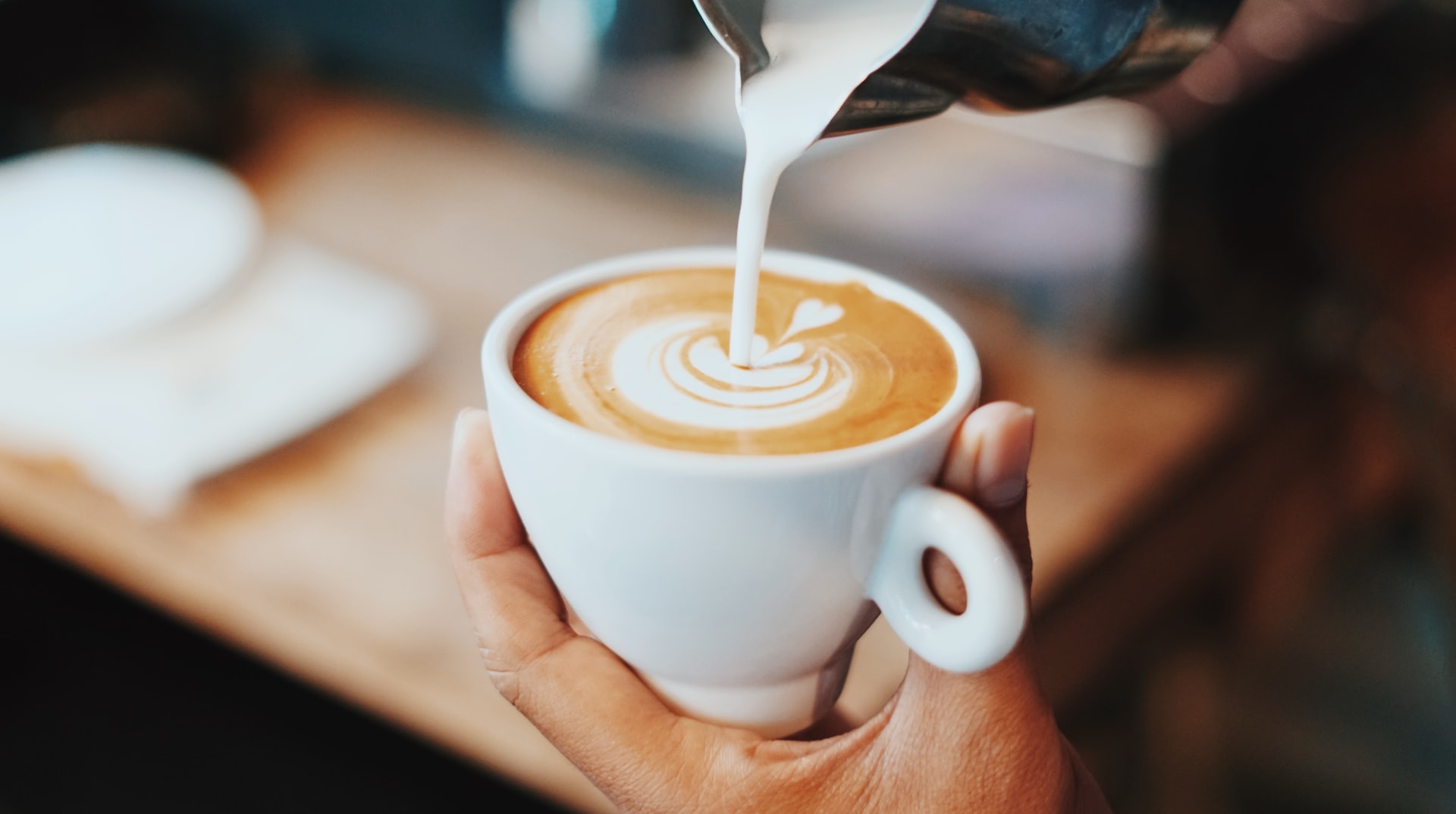
Coffee orders can be confusing, and that’s even before you are asked how you’d
like your coffee made. When it comes to milk based coffees, you will either
want your coffee to be ‘wet’ or ‘dry’. For example, you may hear people ask,
‘Please may I have a dry cappuccino?’ or ‘I’d love a wet flat white please’.
Wet milk is creamier as it has been steamed with little aeration. This makes
it ideal for a flat white, cortado or latte milk based coffee. Dry milk
however has been frothed and aerated for longer. Not only will there be more
froth but the coffee will stay warmer for longer as the froth insulates the
drink and brings out the bitterness more in the espresso shot. Each coffee
shop will make their milk coffees differently so some people will like to tell
you how they specifically like their coffee.
There is an art to perfectly heating milk to get the right flavour and texture
in coffee and people all over the world argue over what temperature really is
right when it comes to milk based coffee. Some believe that 70 degrees Celsius
is best, others swearing by 65 degrees Celsius. A quality industrial milk
steamer with a “frothing function” will steam and froth milk in two stages.
First is the process of aerating or ‘stretching’, introducing air to the milk.
This produces micro-foam and increases the milks volume. The second stage is
emulsifying, which mixes in the microfoam and creates a rich, thick and smooth
milk.
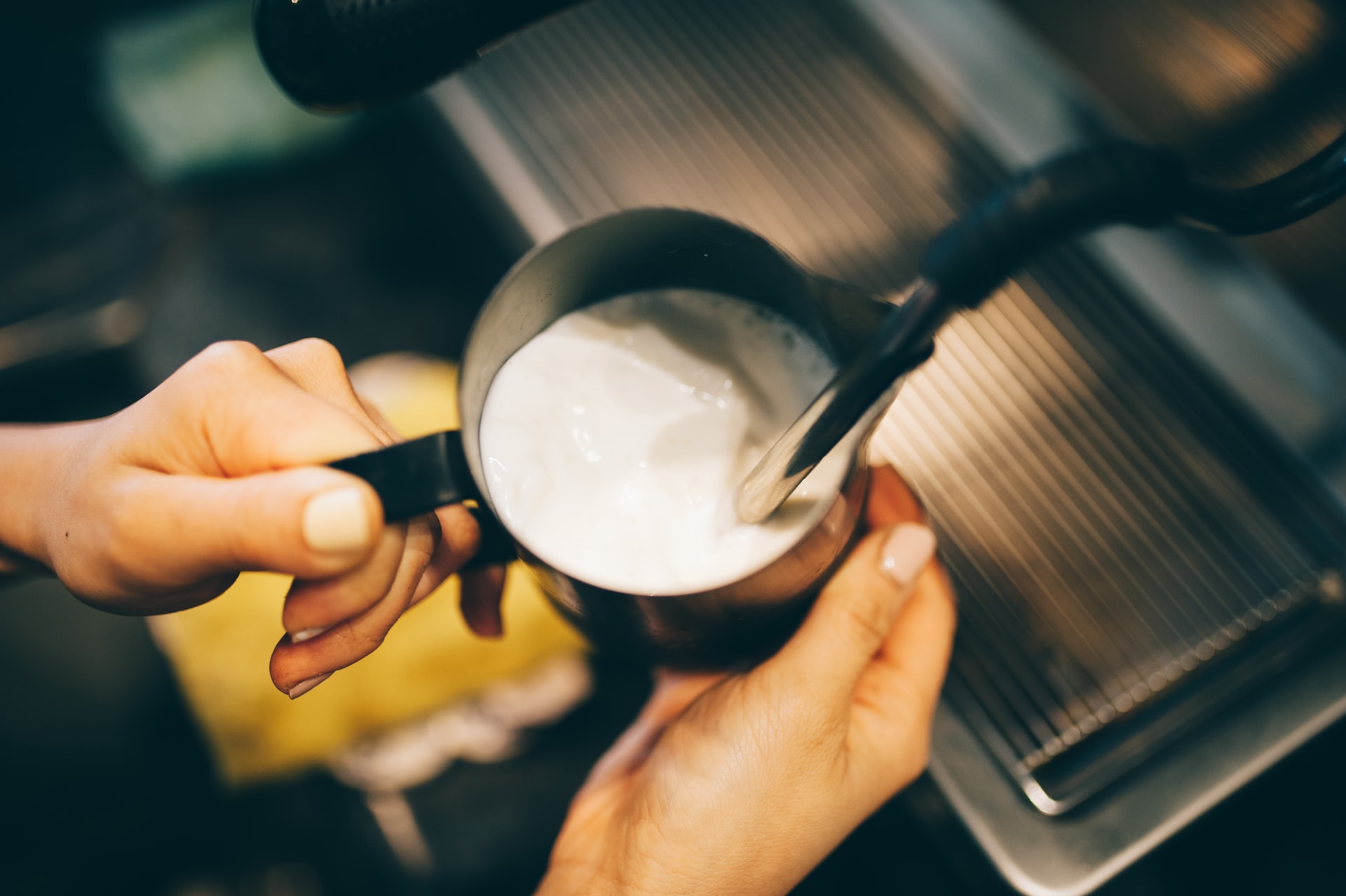
Then there are cold coffee drinks with frothy cold milk. These modern milky
coffee drinks cannot be prepared by hand-frothing (manually with a steam
wand). This milk preparation is known as “cold foam” and requires a commercial
milk frother. Are you in the market for milk frother? Then skip to the bottom
paragraph to find out more about
Latte Art Factory. Cold foam is used in iced coffee drinks – such as an Iced Latte.
There are plenty of people who are lactose intolerant or vegan. Luckily there
are numerous non-dairy barista milk alternatives available today. While a
quality coffee machine is essential, an experienced barista will know how to
froth alternative milks to stop them curdling, as they may react differently
to dairy milk. Alternative milks include nut milks (almond, cashew, coconut),
soy milk or oat milk. These types of drinks need high quality professional
milk foamers that can cope with different temperatures and textures. Having
the right milk frothing machine for coffee shops is really important, especially during busy periods.

If you are looking for a milk frothing machine that will improve your
workflow, efficiency and speed of delivery, without compromising the quality
of coffee you produce, then we have the machine for you. Allow us to introduce
the Latte Art Factory’s milk frother. It is the
leading milk foaming machine
on the market, that allows you to make any milk foam texture from any milk
type.
With this machine, you will be able to serve perfect foam at the optimum
temperature, optimize workflows without leaving customers waiting for ages,
reduce your wastage and save money. It also has full HACCP compliance, with an
automated water flush of the system after every order. Furthermore, this
assures that no non-dairy alternative milk-based coffee is contaminated with
dairy milk and vice versa.
Read more about
Latte Art Factory
or
contact us
today to purchase this award-winning machine for your café!
These days, most cafés have abundant menus, brimming over with mouth-watering
milk coffee drinks made using commercial coffee machines. This comes as no
surprise.
Over the years, the coffee industry has boomed. Statistics tell us that more
than 20 billion pounds in weight of coffee is produced every year across the
globe – that equates to around $55 billion! This means that the focus is very
much on having the right equipment to deliver customers with the best quality
coffee drinks.
Coffee has come a long way from its origins in 15th century Arabia when it was
enjoyed black and strong. Of course, while black coffee has always had its
place and Espresso is still a global favourite, we can thank the Capuchin
friars in the 1600’s for the name of the drink that’s still so popular today.
The Capuchin friars were responsible for “Cappuccino” due to their robes
resembling a coffee drink with frothy milk on top.
There are lots of different variations of the story, some people say that one
of the monks actually drank a bitter black coffee and added frothy cream on
top to change the flavour. At the same time, other countries were also
starting to add milk to their coffee but it didn’t have that “frothy” texture
created by blending air with milk (which was done by hand).
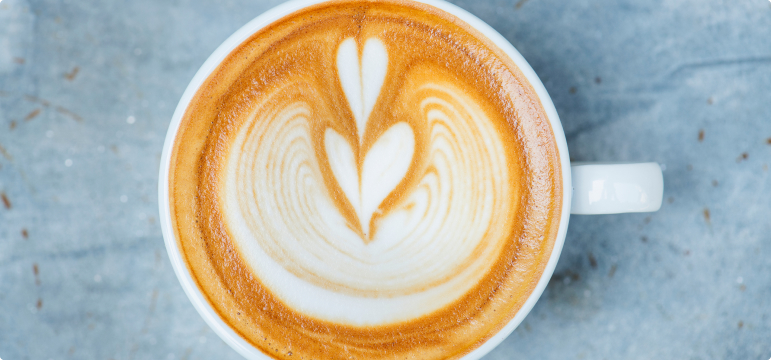
It’s fair to say that over the past forty years, there’s been a revolution in
the coffee industry. While at home, people added milk to their coffee and
coffee with milk was available in restaurants, the start of “novelty” coffee
drinks was in the 1980’s. The Latte, created in the USA, immediately gained a
cult following as did the Café au Lait in Europe.
It wasn’t just a case of adding milk to coffee. There was much more to
creating fabulous flavour and texture. Much of that was in preparing the
frothiness, but commercial milk steamers weren’t available yet, and the work
was done by hand with a steam wand. Even nowadays, much milk frothing is done
by hand using a steam wand, which takes time.
Today, when you Google the top coffee drinks, there’s a common theme. The
types that consistently make the top ten include the Latte, Cappuccino,
Macchiato, Americano and Flat White, followed by Espresso. In the hospitality
industry, to get these drinks perfected quickly, commercial milk frother
machines are essential, especially as frothing by hand is labour-intensive.
With quite a few statistics available, demand for coffee drinks with milk is
on the rise, which means that demand for
professional milk frothers
is also soaring. In some countries, coffee drinks with milk amount to 60% or
more of coffee drinks sold. In Australia, almost 70% of all coffees bought by
consumers are Lattes, Flat Whites etc.

Coffee drinkers in the UK are more likely to opt for a milk based coffee
drink than an Espressoand according to this,
Americans drank over 67 million Lattes during the period 2017-2018.All of these facts mean that hospitality owners are better equipped with
commercial milk frothers rather than managing with manual steaming wands.
Professional equipment speeds up and delivers orders far quicker than
hand-frothing. In fact, the
Latte Art Factory
automatic milk frother can dispense up to 1.5 liters (1.5 quarts) of latte art
ready milk in 60 seconds!
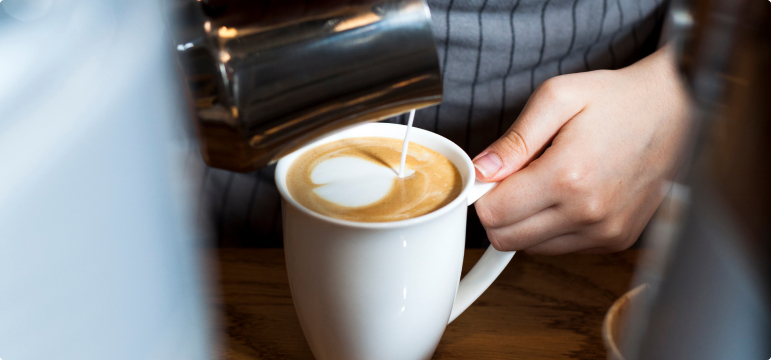
It’s worth mentioning that milk coffee drinks are more profitable for cafes,
hotels and restaurants because they have higher margins, but what are the most
popular milk based coffee drinks?
Of course, there are many more, this list is not exhaustive!
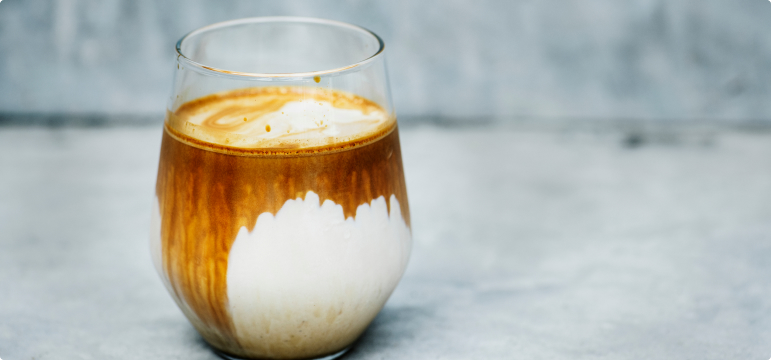
So, what’s the story surrounding these milk coffee drinks that makes them so
appealing? Well, there are many reasons. Not only do they look appealing,
there’s something intensely comforting and soothing when it comes to a
generous helping of fluffy foam sitting on top. There’s some science attached
to that. Milk is a mood enhancer, containing tryptophan, an amino acid which
helps to trigger melatonin, so it’s calming. Plus, the calcium content in milk
can help to boost spirits.
Then of course, lots of people don’t like the intense, strong and bitter
flavour of Espresso. They want something that dilutes the flavour, making it
sweeter and smoother. Additionally, drinking double Espressos all day makes
you feel very jittery! A milk-based coffee is lighter, more “delicate” in its
flavour and delightfully frothy in texture.
Milk has three essential components that add smoothness. Those components are
fat, sugar (from lactose) and
proteins. Combined, those components enhance the flavour and
produce a different type of aroma too. The lactose in milk breaks down into a
sweet flavour when it’s heated up and the protein in milk binds together with
the fat to give it a silky looking texture.
There is an art to perfectly heating milk to get the right flavour and texture
in coffee and there are many views on the right temperature for frothy milk.
Some believe that 70 degrees Celsius is best, others swearing by 65 degrees
Celsius. A quality commercial milk steamer with a “frothing function” should
achieve the optimum temperature and add air to milk, heating up molecules
(these molecules help to create the foamy appearance when blended with air),
making it look thick and fluffy.
Then there are cold coffee drinks with frothy cold milk. These modern milky
coffee drinks cannot be prepared by hand-frothing (manually with a steam
wand). This milk preparation is known as “cold foam” and requires a
commercial milk frother. Cold foam is used in iced coffee drinks – such as an Iced Latte, for
example (check out the new creation “White Hill” for example).
The right equipment is essential for non-milk drinkers who still like a frothy
coffee. There are plenty of people who are lactose intolerant or vegan, and
there are a number of non-dairy alternatives. While a quality coffee machine
is essential, an experienced barista will know how to froth alternative milks
to stop them curdling as they may react differently to dairy milk. Plant milks
include nut milks (almond, cashew, coconut), oat milk or soy. These types of
drinks need high quality professional milk foamers that can cope with
different temperatures and textures.
Having the right
milk frothing machine
for coffee shops is really important, especially during busy periods. There’s
simply no need to waste valuable time hand-frothing anymore. Investing in the
right
milk frothing machine
guarantees that you deliver beverages to perfection very quickly. So, get
ahead of the crowd. Once you’ve captured a customer, you don’t want to risk
losing them to another vendor!
Learn more about the
Latte Art Factory
commercial milk frother orcontact ustoday to purchase this 3x SCA award-winning machine foryour café!
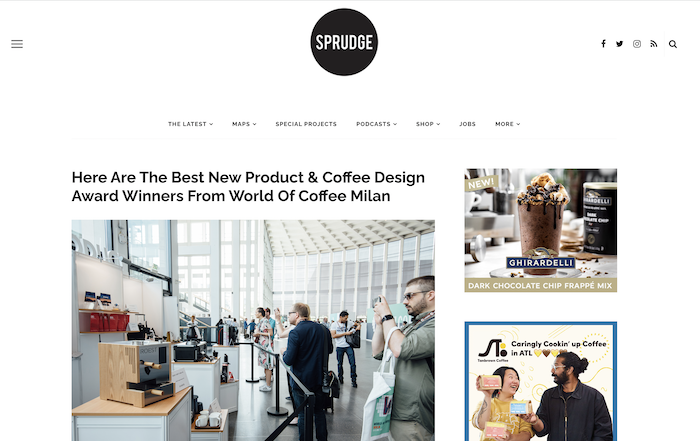
Whether you’re a coffee lover or professional, it’s important to stay up-to-date
on the latest trends in the coffee industry. These 20 coffee blogs, websites and
YouTube channels are our must-follows in 2024. From brewing tips to news about
the latest coffee gadgets, these resources have everything you need to stay
informed about all things coffee. So bookmark them now and check back often—you
won’t want to miss a beat!
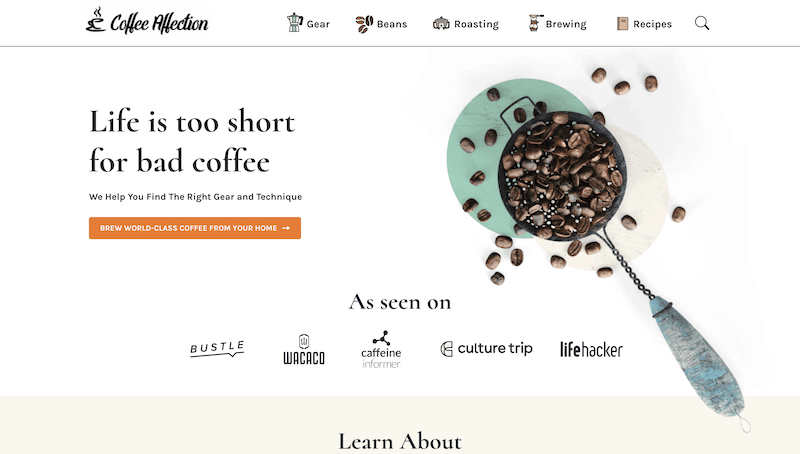
We assume you are reading this article because you have a love of coffee. Then,
this is one of the top coffee blogs for you to follow.
Coffee Affection’s resources are complete with buying guides for both coffee grinding and brewing
instruments, comparisons of brewing techniques and much more. Not sure what bean
is best suited to your pallet? These guys will point you in the right direction.
They also give their honest reviews on equipment.
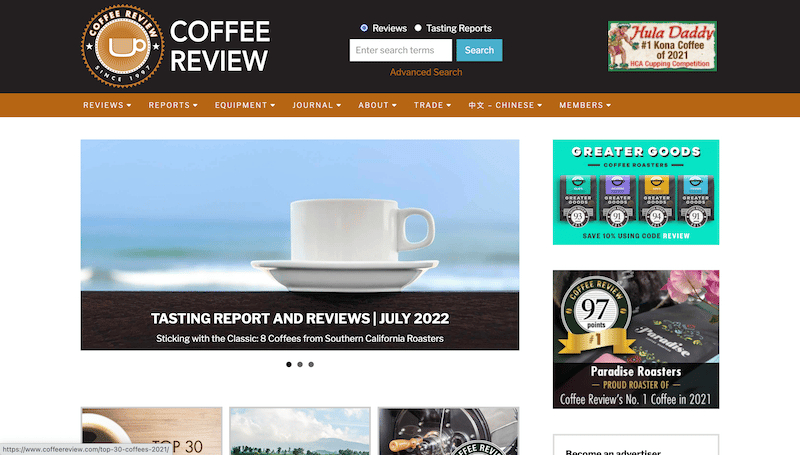
Coffee Review
has been around for a couple of decades. It is one of our goto coffee blogs for
finding coffee reviews, espresso ratings, and coffee articles brought to you by
Kenneth Davids and other leading coffee experts. If you’re interested in
becoming a more informed and rounded coffee enthusiast, then Coffee Review is a
great place to begin your journey.
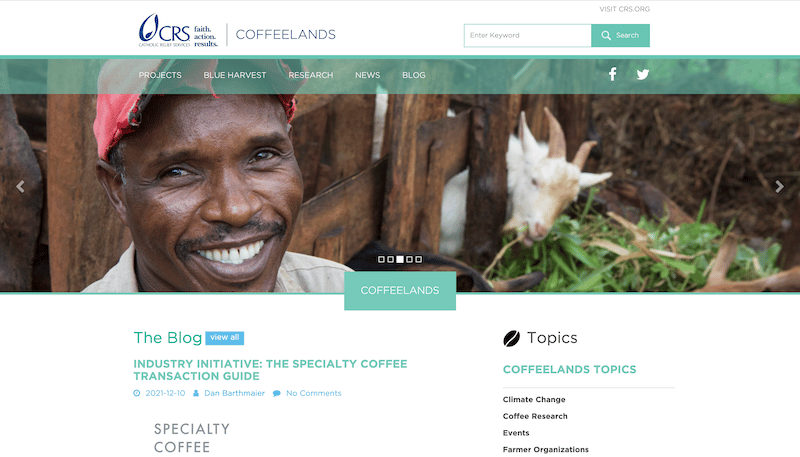
When it comes to coffee, we must talk about where it comes from and ensure it is
sourced from an ethical place where everyone involved in the process is treated
fairly. Introducing
Coffee Lands; their literature illustrates the ethical trade of coffee and introduces us to
the grinding work of kickstarting coffee production. Coffee Lands’ projects are
coordinated by Catholic Relief Services (CRS), whose mission is to support
vulnerable people living in poverty overseas. You can donate to CRS on the
website and follow along with initiating projects.
Obsessed with how your coffee beans are sourced? Look no further…
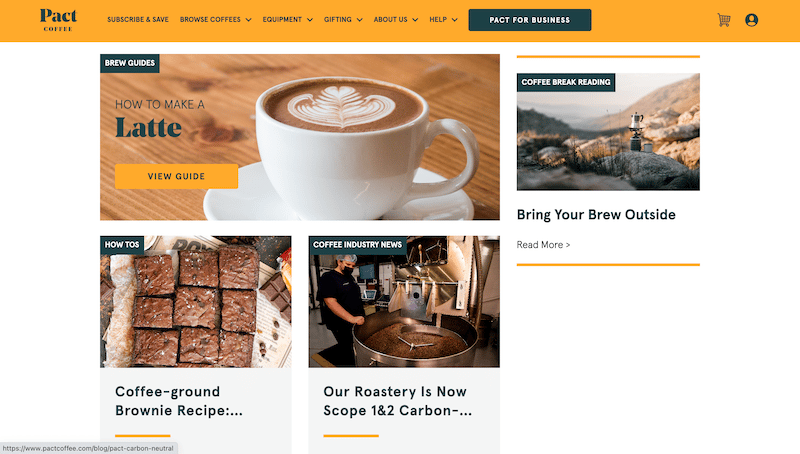
This coffee blog focuses on the entire process of making coffee.
Pact Coffee
will teach you where to find the best beans, how they are sourced and how to
ensure you are drinking ethically sourced coffee. In addition, you will find
tons of brewing guides and recipes.
Discover the best coffee shops in the world
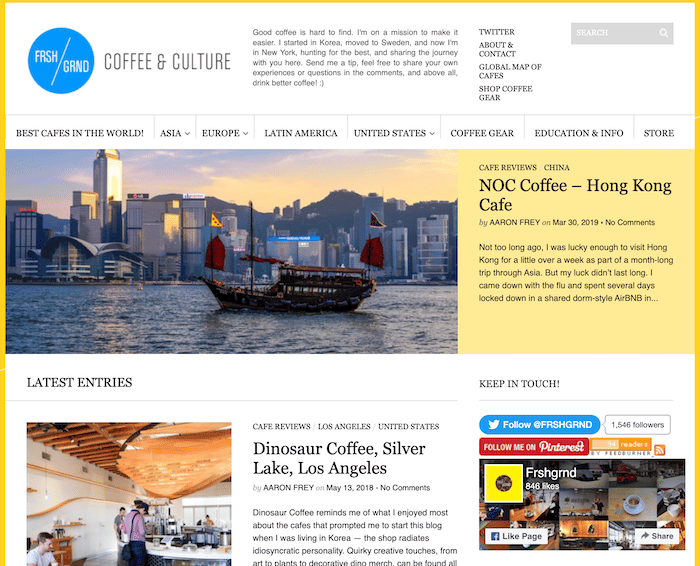
Frshgrnd
takes a different approach from the blogs above. Coffee fanatic, Aaron Frey is
on a worldwide hunt for the best coffee. He has explored countries in Asia,
Europe, and Latin America, and several states in the US. Here, Aaron doesn’t
just learn about coffee, but the places and cultures where each of them
originates from. He also cleverly recommends coffee shops on a nicely displayed
world map, along with a grading scale. Aaron’s goal is to be able to find that
best cup of coffee and share it with all of us.
One of our favorite coffee blogs for equipment reviews and
home brew guides
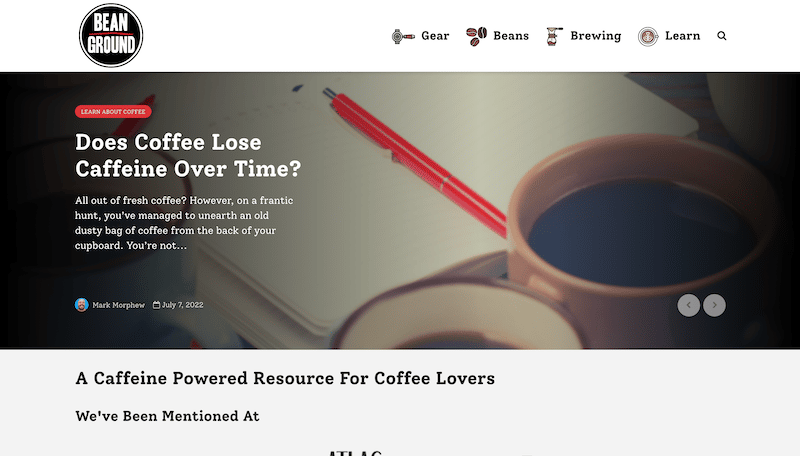
After working in coffee shops around the world, Mark at
Bean Ground
now finds himself testing and experimenting with coffee at home. Learn how to
brew coffee in the comfort of your own home by following the brew guides that
Mark has put together. He also reviews some pretty awesome
coffee equipment.
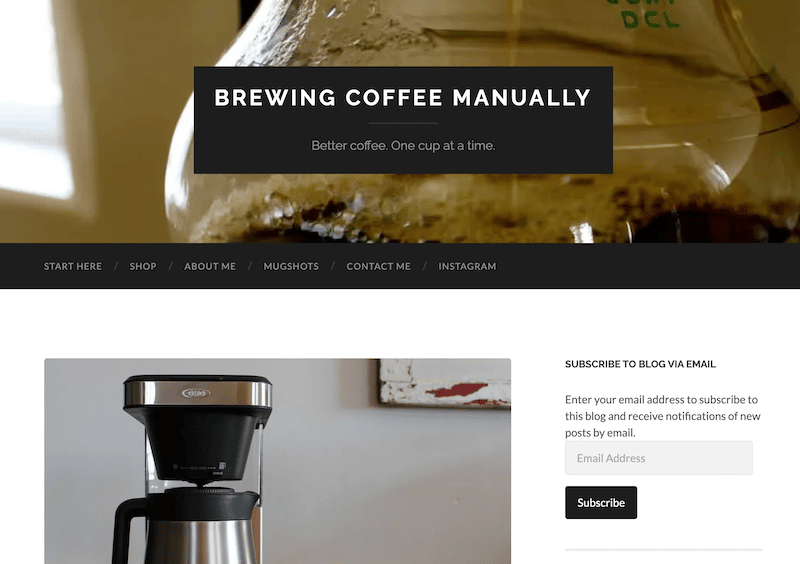
Needless to say, you can probably guess what this blog is about. John, from
Manual Coffee Brewing
has a passion for roasting coffee at home and shares results of his coffee
experiments with you. John will teach you about different techniques of home
brewing including pour-over and immersion. If you would like to learn more about
the techniques involved in home coffee brewing, then this coffee blog is for
you.
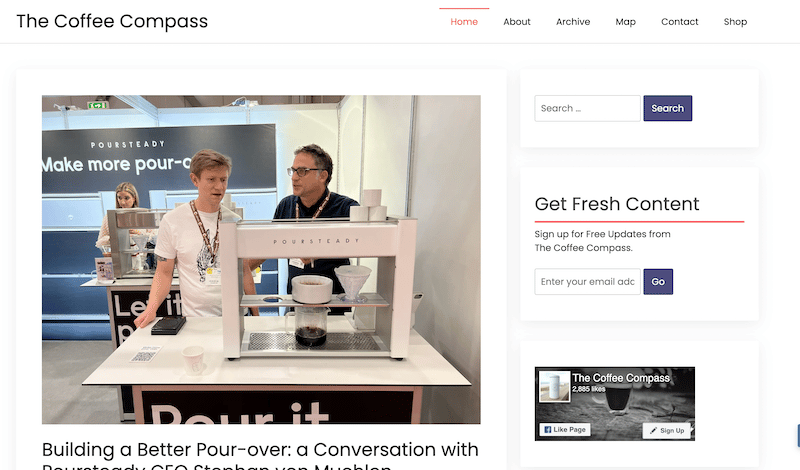
The Coffee Compass
looks at coffee on a global scale and was founded by coffee consultant (yes,
it’s a genuine title), Michael Butterworth who is based in Istanbul while his
co-founding partner, Darren Jennings (creator of RoastWatch) is based in San
Francisco. Michael and Darren review professional coffee equipment and advise
you how to get the best out of it from making iced coffee in an AeroPress along
with coffee book reviews.

This blog is devoted to helping people make great coffee at home by providing
simple, step-by-step guides, reviews of the best coffee beans and machines as
well as tips from some of the world’s top baristas. Whether you are a beginner
or an experienced home barista,
Homegrounds
has something for everyone who wants to make amazing coffee at home.
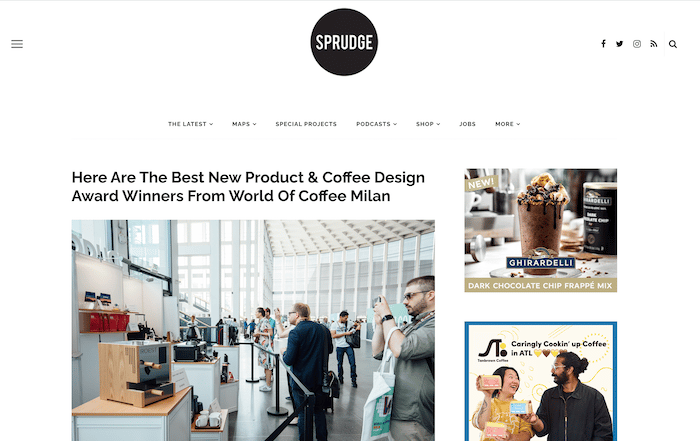
Any guesses what
Spudge
means? You guessed it (well, probably not), it means “coffee crumbs, blotches,
and splats”. This website is great for both individuals and professionals who
are simply looking for up-to-date industry news and events. Keep in the know
with coffee professional interviews.They even have a fancy online merchandise
shop where you can buy from.
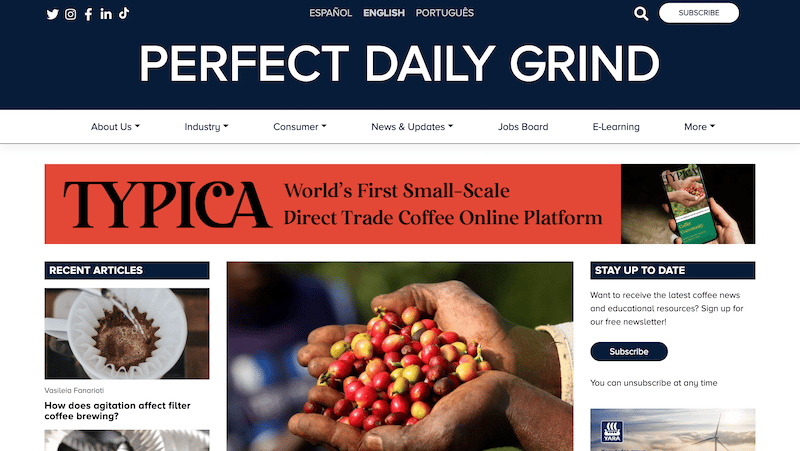
Probably our favorite name for a coffee website.
Perfect Daily Grind
demonstrates how we can all be involved in supporting the coffee supply chain in
a positive manner through its super educational resource. From farming and
trade, to serving up an ethical coffee in your shop, this covers the entire
chain. Whether you are a barista, own a coffee shop, or want to learn more about
the coffee process, Perfect Daily Grind’s articles will lead you on the path of
success.
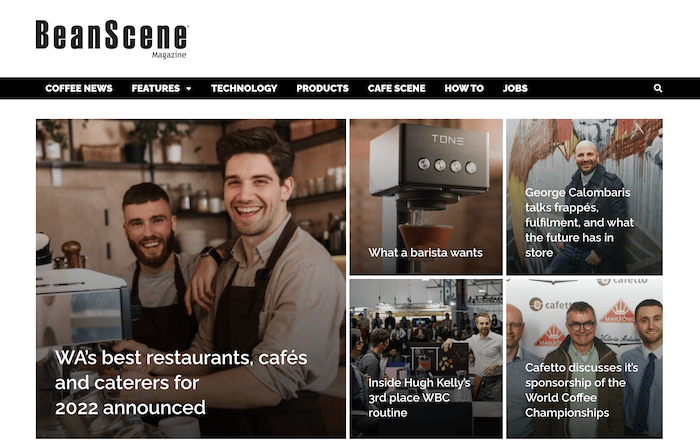
If you are based in Australia, or just have an interest in the Australian coffee
scene, then
BeanScene
is a must-read. The website has a wide range of articles discussing different
aspects of the industry including business tips, new product releases and much
more. You can also find out about all the latest news and events going on Down
Under. Brewing tips and how to’s are also uploaded regularly to keep you
up-to-date.
Daily Coffee News
is a great resource for trade coffee industry professionals, as well as coffee
enthusiasts. With news and articles running daily, you will always be in the
know about what is happening in the coffee industry. From business tips to
in-depth coffee origin stories, this website has it all.
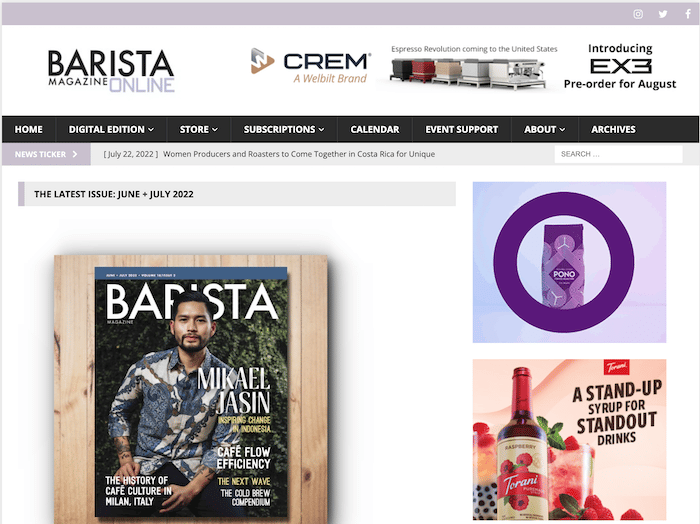
Barista Magazine
is the world’s leading coffee magazine and website, telling the stories of the
people who make our coffee. This website is a great resource for baristas, as
well as coffee professionals, with articles discussing a range of topics from
business and equipment, to barista competitions and product reviews. Whether you
are looking for the latest industry news or just a little inspiration, Barista
Magazine has you covered!
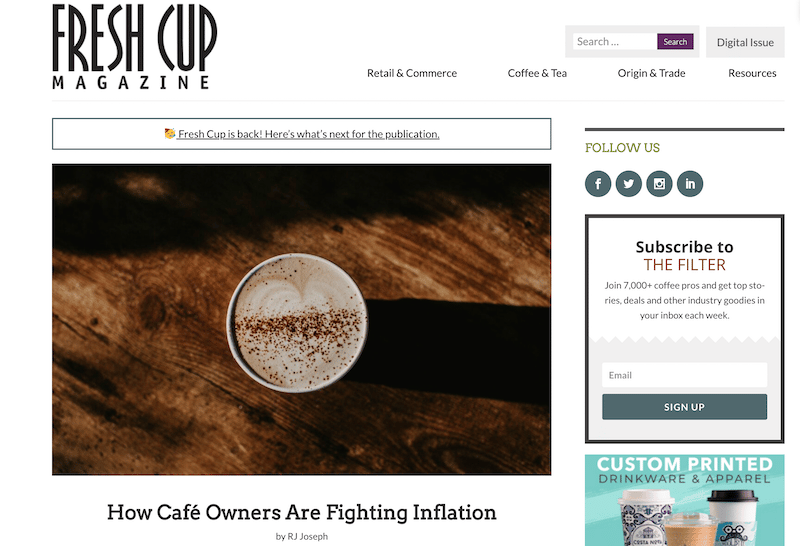
This magazine is perfect for coffee shop owners, managers, and baristas.
Fresh Cup Magazine
features articles on how to run a successful business in a competitive industry,
as well as showcasing new coffee equipment, recipes, and more. What’s more, they
also provide information on tea, showcasing the different regions where it is
grown and made. If you want the best of the coffee and tea industry all in one
place, Fresh Cup Magazine is the perfect resource.

If you are interested in learning more about the coffee culture throughout
Europe, then
European Coffee Trip
is a must-visit website. This website is filled with articles, interviews, and
photos covering the best coffee shops and roasters in each city. Whether you are
looking for tips on how to start your own coffee shop, or simply want some
inspiration for the perfect cup of coffee, European Coffee Trip has it all.
Just because we love coffee so much, we thought we would include a few Youtube
channels that are all about coffee. Whether you want to learn how to make latte
art, or simply want to be inspired by some of the world’s best baristas, these
channels are a great resource.

If you ask any coffee professional, they will undoubtedly have heard of James
Hoffman. He is considered a leading expert in the coffee industry, and is the
author of World Atlas of Coffee, a book that is considered the coffee industry’s
definitive guide.
James Hoffman also runs his own Youtube channel, where he shares tips and advice for both budding and experienced. On his
Youtube channel, James regularly shares videos covering different aspects of
coffee from brewing tips and how-to’s to reviews and video essays all about
coffee. If you want to learn more about the world of coffee, then James
Hoffman’s Youtube channel is a must-follow.

If you are looking for a Youtube channel all about home-brewing and coffee
equipment,
Kyle Rowsell’s channel
is the perfect place to start. He reviews a wide range of coffee equipment, from
entry-level to professional, and provides in-depth brewing tips and tricks.
Whether you are a seasoned barista or just starting out, this channel is sure to
teach you something new.

Morgan Drinks Coffee is a channel by the 2022 U.S. Barista Champion, Morgan
Eckroth, dedicated to all things coffee. Morgan first rose to fame on TikTok,
where she shared humorous videos about the life of a barista and won over
millions of fans. On her
Youtube channel, Morgan continues to showcase her passion for coffee, while also sharing tips
and tricks for anyone interested in learning more about the coffee industry. A
must-follow if you love coffee!

If you are in the market for a new coffee machine, or simply want to learn more
about the different types of machines available,
Whole Latte Love
is the perfect place to start. They have an extensive selection of coffee
equipment reviews and guides, as well as videos on how to optimize your home
barista experience. Whether you are an experienced barista or just starting out,
Whole Latte Love has something for everyone. So why not head over and check out
their massive selection of videos today?
So if you are looking for the best coffee blogs, websites, and Youtube channels
in 2024, be sure to check out the ones listed above! Whether you are a coffee
professional looking for expert advice, or simply want to learn more about the
world of coffee, these resources are sure to help. Thanks for reading, and happy
brewing!